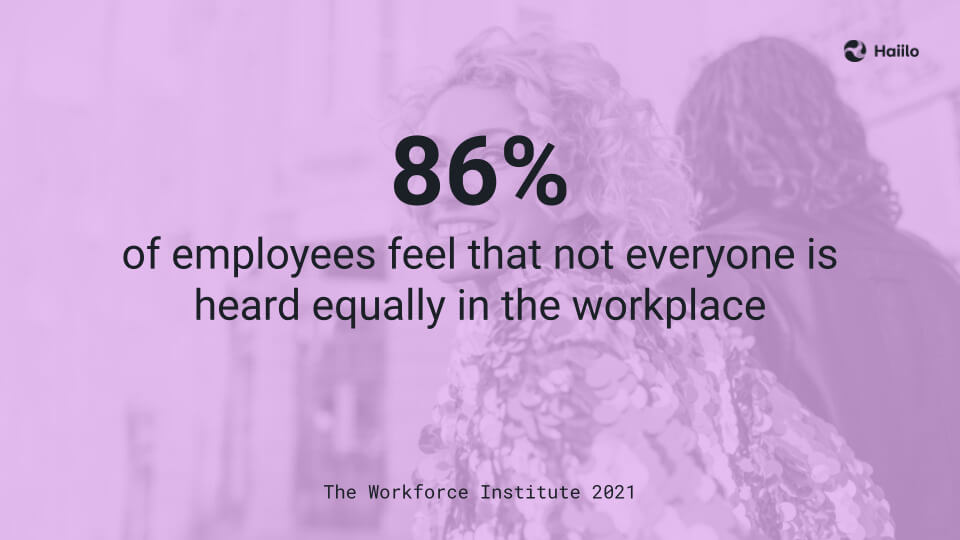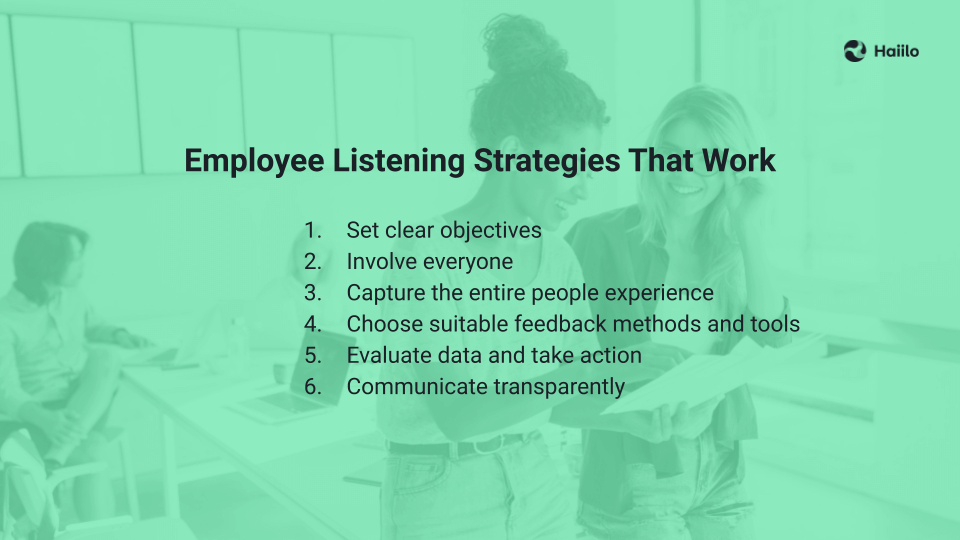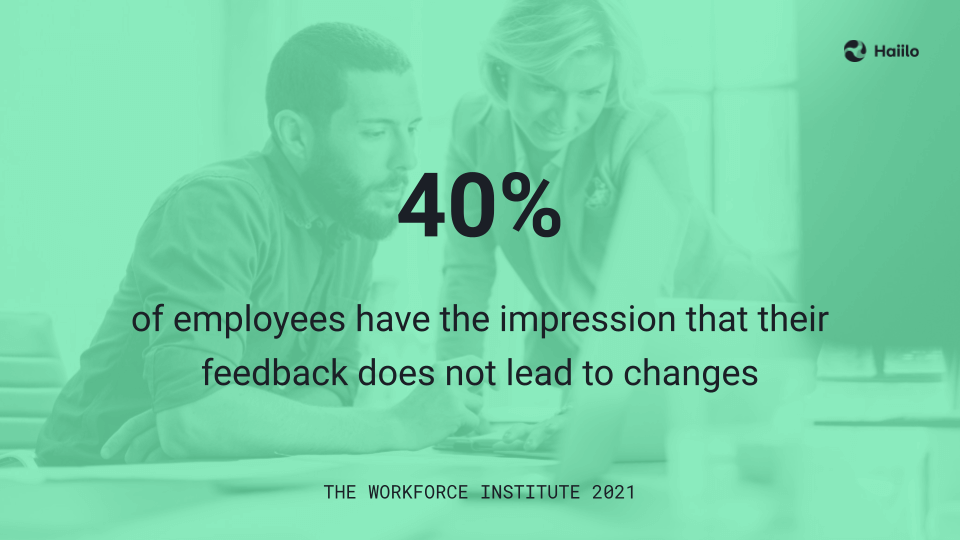Do you know what your employees are currently preoccupied with? Do you know their needs, wants and concerns? If not, then you should start listening and paying attention, using the practised principles of Employee Listening. This is not just a fancy term for the process of listening, but rather an important strategy to gather valuable insights about your company.
In this blog, we look into what Employee Listening offers companies, and their employees and how to build a robust and consistent employee listening strategy.
What is Employee Listening?
In essence, Employee Listening means active listening. It involves understanding your employees better and gaining insight into their daily experiences within the company. The primary method for Employee Listening is conducting employee surveys, but employees should also have the opportunity to provide continuous feedback beyond that.
The Business Rationale for Employee Listening
When employees feel heard, engagement levels soar. Research by the Workforce Institute at UKG showed that 74% of employees feel more effective and engaged when they believe their voices are heard at work. This intrinsic value of feeling heard extends beyond employee engagement alone, as organizations with fast feedback loops can also make quicker changes and innovations, leading to increased profitability.
The goal is to use the insights from the feedback loop to make better decisions for your company, and specifically at an exec level. Quite simply, continuous Employee Listening offers ongoing learning potential for the business, and valuable actionable insights.
The Benefits of Active Listening within a Company
Employee Listening can specifically provide you with valuable insights into the employee experience & satisfaction. However, hybrid and remote work make active listening to your employees much more challenging, and organizations need to find ways to make it work, and include it as part of positive team communication methods. Additionally, there are several other reasons why you should listen to your employees:
- Employee Listening encourages you to actively engage with your employees, maintain a strong relationship, and strengthen employee loyalty. Your employees, in turn, should build a stronger bond with your company.
- Employees gain trust in the leadership team, and your business decisions when they are involved in the process. This, for instance, increases acceptance of change.
- You remain well-informed and learn what is happening within your company and teams. For example, you gain insight into ongoing developments, topics, or issues that are currently occupying your employees.
- The data obtained through Employee Listening serves as a basis for your company’s decision-making. You uncover improvement potentials and can derive well-founded strategies and actions to pursue your company’s goals.
- Active listening demonstrates appreciation to your employees, which positively affects their satisfaction.
- Satisfied employees who feel heard, and involved are known to be more motivated and engaged in their work over time.
- Productivity also increases when you utilize continuous employee feedback to improve processes and provide a productive working environment.
- Overall, your company becomes more agile, allowing you to respond more flexibly to changes and propel your company forward.
Data proves out the importance of listening to your employees. According to research, 86% of employees and executives cite lack of collaboration or ineffective communication for workplace failures.

Continuous Employee Listening – Here’s How to Do It Right
A proven method for Employee Listening is conducting employee surveys. However, this doesn’t mean sending out the traditional bi-annual questionnaires that are common in many companies.
Instead, you should offer feedback opportunities at each significant touchpoint of the employee journey. For example, seek feedback on the onboarding process, collaboration tools used, employee benefits, training sessions, or regularly check the overall sentiment and mood.
In addition to traditional questionnaires, other methods are available. For instance, you can use short pulse surveys via your HR tool. Alternatively, you can analyze posts and comments on your social intranet. For comprehensive insights, rely on the tried and tested method of personal conversations.
- To establish active listening in your company, a cultural shift can sometimes be necessary:
- Cultivate an open feedback culture where honest feedback is always welcome and encouraged.
- Build a relationship of trust, so that employees feel comfortable asking uncomfortable questions or making mistakes. This is essential for learning from each other and growing together.
- Encourage employees to use all channels for feedback, preferably directly. This way, you receive valuable real-time insights.
- Be open to dialogue, interact with your employees, and accept their invitations to have conversations.
Continuous listening means being constantly prepared to receive feedback and providing your employees with the necessary tools, channels, and conditions to provide feedback easily and quickly.
Essentials of a Good Employee Listening Strategy
To enable continuous listening and make the most of your employees’ feedback, you need a well-thought-out Employee Listening Strategy. It’s not effective to simply listen to feedback from all directions without control. Instead, consider how you can gain the best insight into the Employee Experience and act on the findings.
Here are six key points to consider in your strategy:

1. Set Clear Objectives
Always keep your overall company strategy in mind when developing your Employee Listening Strategy. Ask yourself how you want your company to evolve and what insights you want to gain from Employee Listening.
Based on this, set clear objectives in the first step. For example, your goal might be to increase employee motivation, provide more efficient training for your employees, evaluate current change processes, or improve overall internal communication.
Only with clear objectives can you listen in the right places and ask the right questions to the right people. We’ll explore this point in more detail later.
2. Involve Everyone
Employee Listening has a significant impact on the overall company culture. Therefore, it is crucial to involve everyone – not just stakeholders (especially members from HR, Marketing, Corporate Communications, and Management) but all employees as well for effective buy-in of any insights.
Communicate the goals of your strategy, what you expect from your managers and employees, and the benefits of Employee Listening for everyone. Consider offering appropriate training, for example, to provide tips for active listening to supervisors or to familiarize employees with the chosen methods and tools.
3. Capture the Entire People Experience
Some employees may feel less heard than others. According to a study by The Workforce Institute conducted in 2021 with over 4000 employees worldwide, employees in essential jobs, for example, feel that they have less influence on company decisions. New employees may also feel less heard compared to managers.
When we say involve everyone, we mean exactly that. Include remote employees, freelancers, and part-time workers, as they are all important members of your workforce and can provide valuable insights.
Let everyone have their say. Get a holistic overview of the entire People Experience, including the experiences of applicants and former employees.
4. Choose Suitable Feedback Methods and Tools
Once you have defined your goals, target groups, and touchpoints, you can choose the appropriate tools to implement your Employee Listening Strategy.
Here are some examples of how to listen with the right tools actively and continuously:
- Use your HR software to conduct regular pulse surveys on employee satisfaction.
- During offboarding, conduct comprehensive interviews to gather feedback on the employee’s entire journey with your company.
- Encourage regular 1:1 conversation between employees and their supervisors to support individual development and growth.
- Use your employee app to send online surveys directly to employees’ smartphones, asking what they need for more productivity while working from home or hybrid.
- Activate the comment function on your social intranet and encourage employees to provide feedback on your posts.
- In a modern intranet, such as Haiilo’s social intranet facility, you can create your own pages or communities where employees can freely share suggestions and ideas on relevant topics.
Benefits of Digital Employee Listening Software
Let appropriate software support you in Employee Listening. Digital tools like a social intranet offer numerous advantages:
- They are always available to everyone and everywhere. Regardless of where your employees are, they can accept your feedback offer when it suits them best. This ensures that you reach all employees and that nobody is excluded, provided you give them access, for example, through a mobile app.
- Digital feedback is easy to track, and you have a complete overview of the most important topics and trends.
- Integrated analysis capabilities allow you to evaluate your survey results directly in the software and analyze interactions in the intranet. This way, you can always draw the right conclusions from the results. Haiilo’s survey tool even provides real-time results, allowing you to monitor developments directly.
- You can initiate automated processes, such as perfectly timing your surveys.
- Using ready-made templates allows you to create surveys more quickly. You can also standardize them for comparison and identification of trends.
5. Evaluate Data and Take Action
After collecting data through various methods, it’s time to analyze what you’ve heard. Share the results with your employees, for example, by preparing a short report for each survey. But don’t just leave the results without action; derive concrete actions from them. Learn from them and show your employees the impact their feedback has on the company’s development.
For example, if your last survey indicates that your employees are not efficiently using your internal communication tool, perhaps training is needed. Or maybe it’s not the employees’ qualifications but the tool itself. In that case, you should consider introducing new tools for internal communication. Or are your employees overwhelmed by the volume of information in your company as a recent Harvard Business Review report stated? In that case, personalized and audience-specific communication is needed so that your employees receive relevant information at the right time through the right channel.
In summary, active listening also means asking follow-up questions and trying to understand the feedback correctly. Always discuss the results with the wider team and invite further dialogue to improve overall employee experience. This way, you create a continuous listening process.

6. Communicate Transparently
Your Employee Listening Strategy should always be accompanied by a clear communication strategy. Involve your employees at every step and provide transparent information about:
- The purpose of Employee Listening
- The type, timing, and scope of your surveys and other measures
- How their data will be handled
- The results and what will be done with them
- Your successes
This way, your employees can follow what happens with their feedback and its impact. When 40% of employees get the impression their feedback is not listened to in recent studies, it’s imperative that you show more than lip service in this exercise.
Tips for Improved Employee Listening
To ensure that your Employee Listening Strategy is successful, consider the following points:
Ask the Right Questions to the Right People
Just as your employees are individual, you should also approach Employee Listening individually. Carefully consider when to conduct each survey and for what purpose – and who the right contacts are.
Your surveys, for example, could focus on specific events, topics, or teams. Accordingly, you should choose your questions carefully. Always ask only relevant, constructive, and audience-specific questions.
Ideally, your surveys should build on each other, using follow-up surveys to delve deeper into specific aspects or define your target groups more precisely. You might consider involving a focus group – a selected group of employees with whom you conduct in-depth interviews to enrich the quantitative data with qualitative information.
Handle Your Employees’ Data Confidentially
An essential prerequisite for the success of Employee Listening and an open feedback culture is trust. This includes handling your employees’ confidential data properly. Your employees must be able to trust that their responses to anonymized surveys cannot be traced back to them.
For employees to feel comfortable providing honest feedback and expressing their opinions, they need to feel at ease and have confidence in you.
Furthermore, it is also necessary for data protection reasons to handle your employees’ data with care.
Avoid Survey Fatigue
Continuous listening does not mean bombarding your employees with surveys all the time. This is not effective and will ultimately lead to the surveys becoming a nuisance, resulting in a decline in participation rates. Surveys that are too complex or time-consuming can also cause survey fatigue.
Your employees could lose interest in Employee Listening if there are no follow-up actions and they don’t know what happens with the results. They might ask themselves, “Why bother at all?”, which could be even more negative.
Reach Your Employees Across All Channels
An essential factor for a successful Employee Listening Strategy is not relying on a single channel. Many deskless employees, for example, may not have their own email address – excluding them from email surveys. Consequently, you lose important insights and perspectives.
With Haiilo, multi-channel communication is incredibly simple:
- You can disseminate your content to various target groups and channels with just a few clicks.
- You have an overview of your most active and strongest channels.
- You can address the needs of your employees with personalized content.
- You can reach your employees wherever they are at any time.
- Your employees can access your content anywhere and at any time through the mobile app – and actively participate.
Our Haiilo Employee Communications Platform provides numerous options to connect with your employees, respond to their needs, and involve them actively. By using Haiilo, you’ll never overlook a voice internally again.
Best employee engagement software
-
What is employee engagement?
-
How do you create an employee engagement strategy?
-
What are the drivers of employee engagement?
-
What’s the relationship between internal communications and employee engagement?









